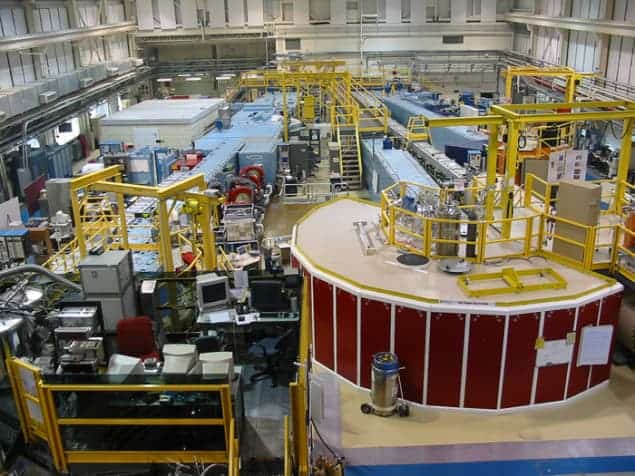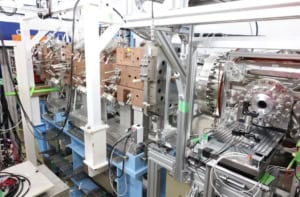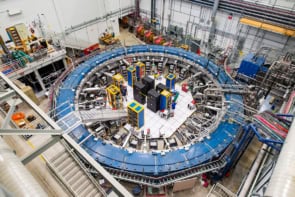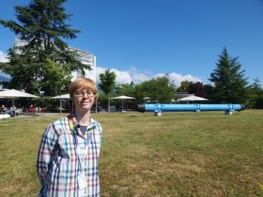
A re-evaluation of a 2005 measurement of the lifetime of the neutron has deepened the mystery of why two different experimental techniques yield two different neutron lifetimes. After recalibrating a key part of their “beam” experiment, physicists in the US confirmed that their value for the neutron lifetime is 8 s longer than that determined by others who had done a “bottle” experiment. What is more, this latest result puts the statistical significance of the discrepancy at nearly 4σ, making it unlikely to be a random anomaly.
While neutrons in stable nuclei can exist for an eternity, a free neutron hangs around for about 15 min before it decays via the weak interaction to a proton, an electron and an antineutrino. A precise measurement of the neutron’s lifetime is important for calculating the rates at which lighter elements were formed immediately after the Big Bang in a process called nucleosynthesis. An extremely good lifetime measurement could also reveal new physics beyond the Standard Model of particle physics.
There are currently two experimental strategies for measuring the lifetime. The bottle method involves trapping neutrons in some kind of container and counting the proportion remaining after a fixed time. The beam method involves monitoring a beam of neutrons and measuring the number of the particles that decay to protons as it passes through a particular volume of space. The systematic errors that could occur in each experiment are different and therefore physicists would be confident in a lifetime value that both techniques agree on.
Bottle and beam disagree
But bottle and beam experiments do not agree. The beam method seems to give a lifetime about 8 s longer than the bottle method, and this discrepancy is significant when compared with the uncertainties of the experiments.
The beam-method measurement with the lowest uncertainty was made in 2005 by Jeff Nico and colleagues at the National Institute of Standards and Technology (NIST) in Gaithersburg, Maryland. The systematic error on this measurement was ±3.2 s, and this was dominated by the uncertainty in the number of neutrons in the beam. Counting neutrons requires a material that, on absorption of a neutron, produces a detectable signal. While a high-intensity neutron beam is needed to provide a reasonable number of neutron decays, absorbing the entire beam would overwhelm the neutron counter. Instead, the researchers used a thin layer of lithium-6 that absorbs only a small proportion of incident neutrons. Knowing this proportion exactly was vital to calculate the lifetime accurately.
New and improved calibration
In 2005 the NIST researchers estimated the absorption probability from the lithium-6 neutron-capture cross-section and the mass of the neutron absorber. Now, Nico has teamed up with Andrew Yue and others to calibrate the same absorber to an accuracy of within 0.05%. This was done by placing the device in a lower-intensity neutron beam and counting the number of neutrons it detected. Another detector called Alpha-Gamma was located downstream from the device, where it measured the entire remaining neutron flux. By comparing the two values, the team could work out almost exactly the proportion of neutrons that its detector had absorbed in the 2005 experiment.
This new information allowed the physicists to reduce the uncertainty of their original neutron-lifetime measurement from ±3.2s to ±1.9s. It also led to a small increase in the value of the lifetime. Consequently, the best available beam and bottle measurements now differ by 3.8σ, rather than the 2005 value of 2.9σ. The researchers are now planning to re-run the entire experiment to try to minimize the errors closer to those quoted for the bottle measurements.
Another decay branch?
The most precise lifetime measurement to date was also made in 2005 by Anatoli Serebrov and colleagues at the St Petersburg Nuclear Physics Institute in Russia. This experiment was done using the bottle method at the Institut Laue-Langevin ultracold neutron source in Grenoble, France. Serebrov points out that, in principle, the discrepancy in measured lifetimes could be explained by another branch of neutron decay that does not produce a proton. Although discovering such a decay channel would be exciting for physicists, Serebrov points out that current theories do not predict an additional decay.
Peter Geltenbort of the ILL is impressed with the latest results from NIST and looks forward to further refinements in both beam and bottle measurements. “Both experiments need to be repeated, and both need to come to an accuracy of below 1 s,” he says. “Then one can talk again about whether there is some completely new physics.” Forthcoming experiments using the bottle technique will be able to count protons emitted from the decaying neutrons as well as recording how many neutrons survive after a given time, he says: “This apparatus will allow you to measure the lifetime of the same ensemble of neutrons by two completely different methods.”
The research is published in Physical Review Letters.
- Physics World spoke to the ILL’s Peter Geltenbort and Oliver Zimmer about the physics of ultracold neutrons in the article “Ultracold neutrons probe the particle-physics frontier”



